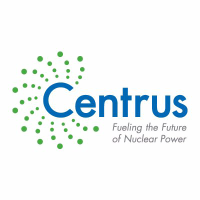
Centrus Energy Corpis engaged in the supply of nuclear fuel and services for the nuclear power industry. It operates through the Low-Enriched Uranium (LEU) and Technical solutions segments. The LEU segment has two components which include the sale of separative work units and uranium. The Technical ... Centrus Energy Corpis engaged in the supply of nuclear fuel and services for the nuclear power industry. It operates through the Low-Enriched Uranium (LEU) and Technical solutions segments. The LEU segment has two components which include the sale of separative work units and uranium. The Technical Solutions segment provides advanced engineering, design, and manufacturing services to government and private sector customers. The majority of the firm's revenue gets derived from the LEU segment. 더 보기
Centrus to Webcast Conference Call on February 7 at 8:30 a.m. ET PR Newswire BETHESDA, Md., Jan. 24, 2025 BETHESDA, Md., Jan. 24, 2025 /PRNewswire/ -- Centrus Energy Corp. (NYSE American: LEU...
Centrus Energy to Participate in Goldman Sachs Energy, CleanTech & Utilities Conference PR Newswire BETHESDA, Md., Dec. 16, 2024 BETHESDA, Md., Dec. 16, 2024 /PRNewswire/ -- Centrus Energy...
Centrus Wins LEU Enrichment Award from U.S. Department of Energy PR Newswire BETHESDA, Md., Dec. 11, 2024 LEU Enrichment Award Marks Third Selection for Centrus under DOE's Nuclear Fuel Supply...
Centrus Energy to Participate in Bank of America's Clean Energy Symposium PR Newswire BETHESDA, Md., Nov. 25, 2024 BETHESDA, Md., Nov. 25, 2024 /PRNewswire/ -- Centrus Energy Corp. (NYSE America:...
Centrus Launches Additional Investment in Centrifuge Manufacturing PR Newswire BETHESDA, Md., Nov. 20, 2024 Investment lays groundwork for potential large-scale uranium enrichment...
Centrus Appoints Neal Nagarajan as Senior Vice President and Head of Investor Relations PR Newswire BETHESDA, Md., Nov. 18, 2024 BETHESDA, Md., Nov. 18, 2024 /PRNewswire/ -- Centrus Energy (NYSE...
| 기간 | 변동 | 변동 % | 시가 | 고가 | 저가 | 평균 일일 거래량 | VWAP | |
|---|---|---|---|---|---|---|---|---|
| 1 | -2.476 | -2.96526946108 | 83.5 | 87.46 | 75 | 798224 | 80.22515705 | CS |
| 4 | -2.776 | -3.31264916468 | 83.8 | 99.57 | 68.1 | 714571 | 80.45455646 | CS |
| 12 | -13.976 | -14.7115789474 | 95 | 99.57 | 64.56 | 838113 | 78.03293739 | CS |
| 26 | 46.244 | 132.96147211 | 34.78 | 118.3599 | 33.51 | 827666 | 77.10437521 | CS |
| 52 | 31.524 | 63.6848484848 | 49.5 | 118.3599 | 33.51 | 521635 | 70.00780749 | CS |
| 156 | 39.264 | 94.0229885057 | 41.76 | 118.3599 | 17.36 | 288073 | 57.77071773 | CS |
| 260 | 74.534 | 1148.44375963 | 6.49 | 118.3599 | 3.76 | 219445 | 51.06014346 | CS |
 Laster
3 월 전
Laster
3 월 전
 Laster
3 월 전
Laster
3 월 전
 Oleblue
2 년 전
Oleblue
2 년 전
 MisterEC
3 년 전
MisterEC
3 년 전
 sambass
4 년 전
sambass
4 년 전
 sambass
4 년 전
sambass
4 년 전
 otcmoneydoubler
4 년 전
otcmoneydoubler
4 년 전
 rteest
4 년 전
rteest
4 년 전
 sambass
5 년 전
sambass
5 년 전
 MisterEC
5 년 전
MisterEC
5 년 전
 MisterEC
6 년 전
MisterEC
6 년 전
 MisterEC
6 년 전
MisterEC
6 년 전
 MisterEC
6 년 전
MisterEC
6 년 전
 Perfectshot23
6 년 전
Perfectshot23
6 년 전
 MisterEC
7 년 전
MisterEC
7 년 전
 donkeyguy1
7 년 전
donkeyguy1
7 년 전
 donkeyguy1
7 년 전
donkeyguy1
7 년 전
 rteest
7 년 전
rteest
7 년 전
 donkeyguy1
7 년 전
donkeyguy1
7 년 전
 donkeyguy1
7 년 전
donkeyguy1
7 년 전
 MisterEC
7 년 전
MisterEC
7 년 전
 MisterEC
7 년 전
MisterEC
7 년 전
 MisterEC
8 년 전
MisterEC
8 년 전
 MisterEC
8 년 전
MisterEC
8 년 전
 MisterEC
8 년 전
MisterEC
8 년 전
 MisterEC
8 년 전
MisterEC
8 년 전
 MisterEC
8 년 전
MisterEC
8 년 전
 coachvw
8 년 전
coachvw
8 년 전
 MisterEC
8 년 전
MisterEC
8 년 전
 MisterEC
8 년 전
MisterEC
8 년 전
 coachvw
8 년 전
coachvw
8 년 전
 MisterEC
8 년 전
MisterEC
8 년 전
 coachvw
8 년 전
coachvw
8 년 전
 MisterEC
8 년 전
MisterEC
8 년 전
 coachvw
8 년 전
coachvw
8 년 전
도움 및 지원받기: kr-support@advfn.com
ADVFN 서비스 이용은 ADVFN의 이용약관에 동의하는 것입니다 이용약관